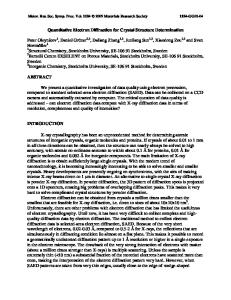Accurate determination of highly volatile chloroethylene by quantitative 1 H-NMR
- PDF / 1,627,243 Bytes
- 9 Pages / 595.276 x 790.866 pts Page_size
- 72 Downloads / 346 Views
ORIGINAL PAPER
Accurate determination of highly volatile chloroethylene by quantitative 1H‑NMR Naoki Saito1,2 · Yuko Kitamaki1 · Toshihide Ihara1 Received: 17 September 2020 / Accepted: 17 October 2020 © Springer Nature Switzerland AG 2020
Abstract In Japan, chloroethylene is a regulated substance under the soil contamination countermeasures act since 2017, due to the presence of chloroethylene in soil leachate and groundwater. As a consequence, chloroethylene concentrations must be accurately determined to ensure the safety of drinking water, yet chloroethylene standard solutions with reliable concentrations have not been available because chloroethylene is difficult to handle due to its boiling point of − 13 °C. Here, we developed a quantitative 1H nuclear magnetic resonance (1H-qNMR) method to measure chloroethylene concentration in a standard solution in CD3OD. Sampling temperature must be between − 80 °C and − 21 °C, and the NMR tube headspace volume ratio must be lower than 23% to reduce the volatilization of chloroethylene. We used the signal of CD2HOD present in the standard solution as an internal standard because chloroethylene was volatilized during the addition of another internal standard. The chloroethylene concentration in the standard solution was accurately determined as 117.7 ± 1.4 mg kg−1. Keywords Chloroethylene · Standard solution · Quantitative 1H-NMR · Solvent signal · Temperature · Headspace
Introduction Chloroethylene, also known as vinyl chloride monomer, is a gaseous colorless compound with a boiling point of − 13 °C under atmospheric pressure. Chloroethylene used to be considered a safe compound and was used as an anesthetic and in hair or fly sprays (WHO 1999; ATSDR 2006). In the late 1950s, two workers at a polyvinyl chloride plant exposed to a high concentration of chloroethylene died of vinyl chloride disease (Danziger 1960). In 1974, three deaths due to angiosarcoma of the liver were reported among workers in a chloroethylene and polyvinyl chloride plant (Creech and Johnson 1974). In addition to tighter controls on domestic Electronic supplementary material The online version of this article (https://doi.org/10.1007/s10311-020-01127-1) contains supplementary material, which is available to authorized users. * Naoki Saito saito‑[email protected] 1
National Metrology Institute of Japan, National Institute of Advanced Industrial Science and Technology, 1‑1‑1 Umezono, Tsukuba, Ibaraki 305‑8563, Japan
Present Address: Center for Environmental Measurement and Analysis, National Institute for Environmental Studies, 16‑2 Onogawa, Tsukuba, Ibaraki 305‑8506, Japan
2
use of sprays containing chloroethylene, various industrial safety standards and regulations were established (Sano 1977). In the 1970s, chloroethylene began to be investigated as a carcinogen by organizations worldwide, including the International Agency for Research on Cancer (IARC) and the United States Environmental Protection Agency (EPA 1976; IARC 1979). Based on animal experiments and epidemiological st
Data Loading...











